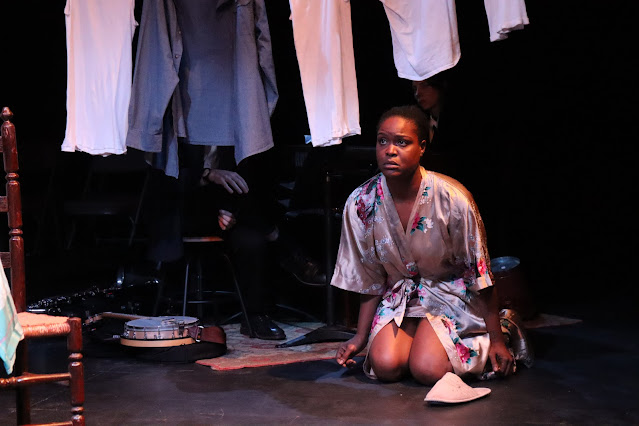Review: “A White Man’s Guide to Riker’s Island” Delivers a Stellar Performance But Gets a Bit Preachy
A White Man's Guide to Rikers Island
Written by Richard Roy and Eric C. Webb
Directed by Thomas G. Waites
Presented at The Producer's Club
358 W 44th St, Manhattan, NYC
July 18-September 29, 2019
 |
| Richard Roy and Connor Chase Stewart. Photo credit: Jacob Goldberg, |
Richard Roy, when he was a young man just making the transition from the suburbs of New Jersey to New York through gigs as a bartender and as a soap opera extra, had a fateful night of partying with booze and cocaine that would leave one young man dead and another uncertain about his future. The play begins with Roy himself performing the opening stream-of-consciousness monologue in which he recounts the events of that night in his early twenties that would land him in Rikers for less than a year. He describes the quick succession of events from drinking with friends to scoring a bag of cocaine to running a red light and hitting a young Puerto Rican man. The young Roy (Connor Chase Stewart) takes over from there, and a good part of the monologue is his recounting of how his lawyer kept him out of Rikers for two years—“wearing the system down” in his words. In A White Man’s Guide to Rikers Island, Roy presents contending meanings for his time in Rikers. One is that Rikers is full of complex humans who can show kindness under the direst circumstances. He quickly befriends his cellmate Shivon, a trans woman whose chest the prisoners fixate on, as well as Saddam, an inmate in an adjacent cell who offers Roy protection. There is a strangely touching scene where Shivon finds him masturbating in the shower and offers to help. The scene comes off not as prurient but kind. Young Roy notes, in one of his asides to the audience that serves as their guide to Rikers, that despite popular belief of what might happen when you drop the soap in prison, the real fear is when you shower facing the wall. Just after Shivon leaves the shower, a member of the Puerto Rican Express gang comes in and starts to carve the gang’s initials on his torso.
 |
| Connor Chase Stewart. Photo credit: Jacob Goldberg, |
For all my complaints, there is plenty in the play that redeems it. There is a simplicity about the staging and performance that adds to the intensity of the subject. The staging is quite simple. Just a blank stage, save for a marker board on an easel as well as a blown-up photo of Roy sparring with Muhammad Ali—he makes the point several times that he briefly trained with him. Aside from the actual Roy coming out for a few minutes at the beginning of the play and just at the end, the rest is a Stewart’s monologue. He plays several characters throughout, including the two friends, Amir, a devout Muslim who writes with him on the Rikers Review newspaper, Dillis, a devout Christian and sympathetic prison employee, and Hector, the uncle of the man Roy killed, who is hunting him down. His ability to switch to each character is impressive. One scene in particular that impresses is when Roy is being held in a chair by Hector with a shiv at his neck. He pulls off the entire confrontation, beautifully moving between the terrified Roy and Hector trying to force him to say his nephew's name.
The play makes the best of its dark topic. There is quite a bit of humor and several very touching moments of human connection. You are almost sad that Roy has to leave Rikers after making such connections with his Shivon and Saddam. However, the play gives up its chance to talk about the larger issue of criminal justice reform, which is fine. Every play does not have to try to solve social problems. However, it settles for the lesson that if Roy’s story can keep someone else from committing crime, then the play will have done its job. But the play is anything but a warning story. There is far more to it than that. The takeaway from it is how people preserve their humanity in awful conditions and are able to adapt to them as well. That’s a reality that has nothing to do with being white.
A White Man’s Guide to Rikers Island plays an extended run at The Producers Club until September 29 [updated 8/19/19].
-Joseph Donica



Comments
Post a Comment